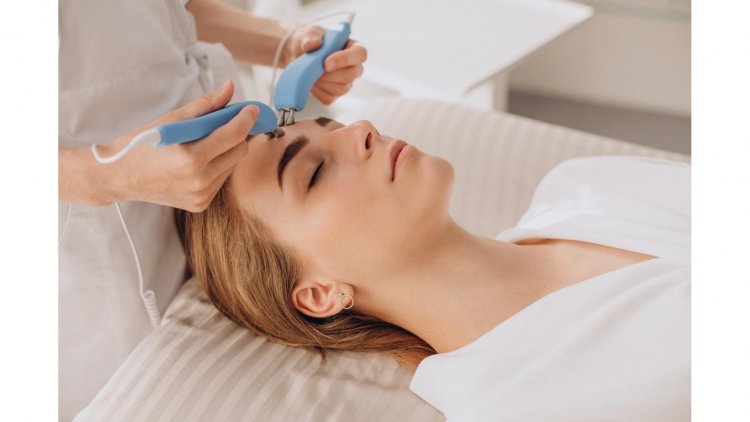The Quantum Leap in Pain Relief: Unveiling the Power of Frequency-Specific Microcurrent Therapy
Pain management is a persistent challenge in modern medicine, with countless therapies and treatments available to alleviate discomfort. Among the emerging options, Frequency-Specific Microcurrent (FSM) therapy stands out as a revolutionary approach that blends the principles of biophysics and neurotherapy to offer a new pathway to pain relief. This article delves deep into the mechanisms, applications, and efficacy of FSM therapy, exploring how it harnesses the power of microcurrent frequencies to target and treat pain.

Understanding Frequency-Specific Microcurrent Therapy
Frequency-Specific Microcurrent therapy is a non-invasive treatment modality that utilizes low-level electrical currents to treat a variety of conditions, including chronic pain, inflammation, and injury. Unlike traditional electrical stimulation therapies, FSM operates at frequencies tailored to the specific type of tissue or pain condition being treated.
The Science Behind Microcurrent Therapy
Microcurrent therapy involves the application of extremely low electrical currents, typically in the range of millionths of an ampere (microamperes). These currents are imperceptible to the patient, meaning they are not felt during treatment. The theory behind microcurrent therapy is that these low-level currents mimic the body's natural electrical processes, which can promote cellular repair and reduce pain.
FSM therapy takes this concept further by using frequency-specific currents. Different tissues and pain conditions respond to different frequencies of electrical stimulation. By applying currents at specific frequencies, FSM aims to optimize the therapeutic effects on the targeted tissues.
The Mechanisms of FSM
FSM therapy operates on the principle that specific frequencies can influence biological processes at the cellular level. The mechanism of FSM involves several key processes:
- Cellular Repair and Regeneration: FSM is believed to enhance cellular repair by stimulating ATP (adenosine triphosphate) production within cells. ATP is essential for cellular energy and repair processes. By increasing ATP production, FSM can potentially accelerate tissue healing and recovery.
- Pain Modulation: Pain relief from FSM may result from its ability to modulate pain signals at the neurological level. The electrical currents used in FSM can influence the way pain signals are processed and perceived by the nervous system.
- Anti-Inflammatory Effects: FSM may help reduce inflammation by influencing the production of inflammatory mediators. Chronic inflammation is a common underlying factor in many types of pain, and reducing inflammation can lead to significant pain relief.
- Improved Circulation: Enhanced blood flow and circulation can aid in the delivery of nutrients and removal of waste products from tissues, which can support overall healing and reduce pain.
Clinical Applications of Frequency-Specific Microcurrent Therapy
FSM therapy has been applied to a wide range of clinical conditions, from acute injuries to chronic pain syndromes. Here are some notable applications:
1. Chronic Pain Management
Chronic pain conditions, such as fibromyalgia, neuropathic pain, and arthritis, have traditionally been difficult to manage effectively. FSM offers a promising alternative by targeting pain at the source with precise frequency settings. Clinical studies have shown that FSM can provide significant relief for individuals suffering from these conditions, often with fewer side effects compared to conventional pain medications.
2. Sports Injuries and Rehabilitation
Athletes frequently encounter musculoskeletal injuries, including strains, sprains, and tendonitis. FSM therapy has been used to expedite the healing process for sports-related injuries. By applying specific frequencies, FSM can help reduce inflammation, alleviate pain, and accelerate tissue repair, enabling athletes to return to their activities more quickly.
3. Post-Surgical Recovery
Post-surgical recovery often involves managing pain and promoting healing of surgical sites. FSM therapy has been utilized to improve recovery times and reduce postoperative pain. By supporting the body’s natural healing processes and reducing inflammation, FSM can be an effective adjunct to traditional post-surgical care.
4. Neurological Conditions
Some neurological conditions, such as stroke recovery and multiple sclerosis, have also benefited from FSM therapy. The therapy’s ability to enhance cellular repair and modulate pain can contribute to improved outcomes in neurological rehabilitation.
5. Aesthetic Applications
Beyond medical and rehabilitative uses, FSM therapy has found a niche in aesthetic medicine. It is employed in non-invasive facial treatments to promote skin rejuvenation and reduce wrinkles. The low-level currents stimulate collagen production and improve circulation, offering a cosmetic benefit in addition to therapeutic effects.
The Research and Evidence Supporting FSM Therapy
The efficacy of Frequency-Specific Microcurrent therapy is supported by a growing body of research, although it remains a developing field. Clinical trials and studies have demonstrated positive outcomes for various conditions treated with FSM. For instance, research has shown that FSM can effectively reduce pain and improve function in patients with chronic pain conditions.
Key Studies and Findings
- Chronic Pain and FSM: A study published in the Journal of Pain Research found that FSM therapy significantly reduced pain and improved function in patients with fibromyalgia. Participants reported decreased pain levels and enhanced quality of life following FSM treatment.
- Sports Injuries: Research in The American Journal of Sports Medicine highlighted the benefits of FSM in reducing recovery time and improving outcomes in athletes with acute musculoskeletal injuries. The study noted significant improvements in pain reduction and tissue repair.
- Post-Surgical Pain: An investigation in the Journal of Orthopedic Research evaluated FSM’s impact on postoperative pain management. Results indicated that FSM therapy could effectively reduce pain and promote faster recovery following surgical procedures.
- Neurological Rehabilitation: A clinical trial reported in Neurorehabilitation and Neural Repair demonstrated that FSM therapy could enhance motor function and reduce spasticity in patients recovering from stroke.
Practical Considerations and Implementation
Implementing FSM therapy involves understanding the specific frequencies required for different conditions and ensuring proper application techniques. It is essential to work with a trained practitioner who can tailor the treatment to individual needs.
Choosing the Right Practitioner
For those interested in FSM therapy, selecting a qualified practitioner is crucial. Look for professionals who have received specialized training in FSM and have experience in treating your specific condition. Practitioners may include physical therapists, chiropractors, and other healthcare providers trained in FSM.
Treatment Protocols
FSM treatment protocols vary depending on the condition being treated. Sessions typically last between 30 to 60 minutes and may be repeated several times a week. The frequency and duration of treatment depend on the severity of the condition and the patient's response to therapy.
Safety and Side Effects
FSM therapy is generally considered safe, with minimal side effects. However, as with any therapeutic modality, it is essential to discuss any potential risks with your healthcare provider. Some individuals may experience mild discomfort or temporary changes in sensation during or after treatment.
The Future of Frequency-Specific Microcurrent Therapy
As research continues and technology advances, the future of Frequency-Specific Microcurrent (FSM) therapy looks promising. Innovations in FSM technology and growing clinical evidence suggest that this therapy will become an increasingly integral part of pain management and rehabilitation strategies.
Emerging Technologies and Trends
- Advancements in Equipment: The development of more sophisticated FSM devices with enhanced precision and user-friendly interfaces is expected. Newer models may offer greater flexibility in frequency settings and improved monitoring of treatment outcomes.
- Integration with Other Therapies: FSM therapy is increasingly being combined with other modalities, such as physical therapy, acupuncture, and nutritional interventions, to create comprehensive treatment plans. This integrative approach can optimize therapeutic outcomes and address multiple aspects of health and recovery.
- Personalized Treatment: Advances in data analytics and wearable technology may allow for more personalized FSM treatment plans. By analyzing individual responses to various frequencies and treatment protocols, practitioners can tailor therapies to better meet the needs of each patient.
- Expanding Applications: Research is likely to uncover new applications for FSM therapy beyond its current uses. Potential areas of exploration include mental health conditions, autoimmune disorders, and more intricate aspects of neurological rehabilitation.
Challenges and Considerations
Despite its potential, FSM therapy faces several challenges that need to be addressed:
- Standardization: There is a need for standardized treatment protocols and frequency settings to ensure consistent results across different practitioners and conditions. Establishing such standards will enhance the credibility and reliability of FSM therapy.
- Research and Evidence: While initial studies are promising, more extensive and rigorous research is necessary to fully validate the efficacy and safety of FSM therapy for various conditions. Long-term studies and randomized controlled trials will be crucial in establishing FSM’s place in mainstream medicine.
- Cost and Accessibility: The cost of FSM devices and treatments can be a barrier to accessibility for some patients. Efforts to make FSM therapy more affordable and widely available will be important in expanding its use.
- Training and Education: Ensuring that practitioners receive thorough training in FSM therapy is vital. Continued education and certification programs can help maintain high standards of care and effective treatment.
Patient Experiences and Testimonials
Patient testimonials often highlight the transformative impact of FSM therapy on their quality of life. Many individuals report significant reductions in pain, improved mobility, and enhanced overall well-being following FSM treatment. These personal accounts underscore the potential of FSM as a valuable tool in managing pain and promoting recovery.
In summary, Frequency-Specific Microcurrent therapy represents a fascinating and evolving approach to pain management and rehabilitation. By leveraging precise electrical frequencies to target specific tissues and conditions, FSM offers a novel pathway to relief and recovery. The growing body of research and positive patient experiences suggest that FSM has the potential to become a mainstream therapy for various health conditions. However, ongoing research, standardization efforts, and broader accessibility will be crucial in realizing its full potential.
As with any therapeutic modality, it is essential to consult with a qualified healthcare provider to determine if FSM therapy is appropriate for your specific condition. By staying informed and engaged in your treatment options, you can make empowered decisions about your health and well-being.
Disclaimer: The information provided in this article is for educational purposes only and should not be considered medical advice. If you have any health concerns or are experiencing symptoms, it is important to consult with a healthcare professional, such as a doctor or clinic, for proper diagnosis and treatment. Always seek the advice of your doctor or other qualified health provider with any questions you may have regarding a medical condition. Do not disregard professional medical advice or delay in seeking it because of something you have read in this article.
What's Your Reaction?





















